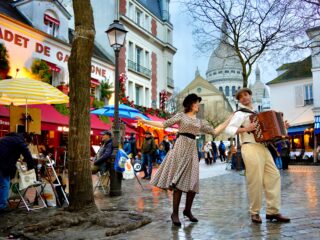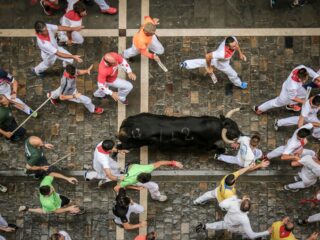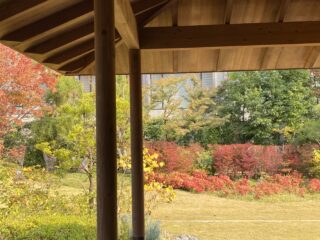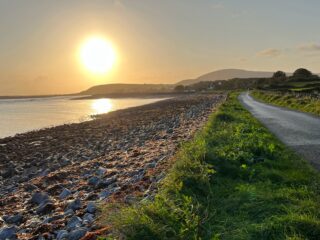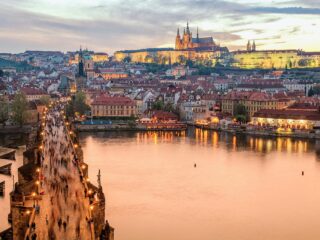By Bill Moake
The lonely desert mesas stretched to a line of mountains etched on the stark blue horizon. At an elevation of 7,000 feet, the morning air was crisp and cool, even though it was July in New Mexico. I was alone in front of a little shrine that reminded me of a country chapel. It seemed an appropriate metaphor considering whose ashes were buried there — author D. H. Lawrence, the “priest of love.”
To the left was the tomb of Frieda, the fiery German woman who became his wife and soul mate on their free-spirited adventures traveling around the world. With Frieda, he explored the deepest mysteries of love and tapped into the wellspring of life which
kept him going long after he should have died from tuberculosis. From her, Lawrence learned the secret of knowing all women through tender intimacy with one woman, a lesson lost in the modern age.
I had tried to make that connection with a woman myself, first in a marriage and then in a succession of relationships, but I never found my Frieda. Lawrence’s writings had been an inspiration to me since I was a teenager and I had come to New Mexico to see if I could commune with his spirit. Call it a mid-life crisis if you like, but I thought of the trip as a visit with an old friend. Morning in the land of enchantment was as exhilarating as Lawrence described:
In the magnificent fierce morning of New Mexico one sprang awake, a new part of the soul woke up suddenly, and the old world gave way to a new . . .
My head was uncommonly clear despite the several beers I drank the previous night at a bar in Taos. The air of the high plateau seemed to breathe new life into my middle-aged, nicotine-stained lungs. I felt like I could run the mile in under six minutes, but I was wise enough not to put this feeling to the test. With age and clogged arteries comes wisdom.
On the leisurely drive to the shrine, I stopped at the Rio Grande gorge to watch a group of white-water rafters plunge down the river. The gorge was an oasis of green in the vast gray sagebrush and tumbleweed mesas. The steep walls of the gorge made it resemble an earthquake crack, a wound in the surface of the land that bled the waters of the Rio Grande. I lingered at the rim, fantasizing about diving into the cold water with all my clothes on just for the hell of it. What a rush that would be! But wisdom prevailed again and I drove on to my rendezvous with Lawrence. He wrote:
I think New Mexico was the greatest experience from the outside world that I have ever had. It certainly changed me forever . . .
I understood what he meant because I felt the same way about Hawaii. Some places simply get under your skin and you can’t imagine living anywhere else. After a vagabond life of travel all over the world, Lawrence and Frieda settled on Kiowa Ranch, the only home they ever owned. The ranch and the surrounding wilderness became his symbolic arena for Life At Large. It was the background setting of philosophical musings he recorded in “Reflections On The Death Of A Porcupine” and other writings.
The ranch is now owned by the University of New Mexico, which allows public access to the D. H. Lawrence Memorial. I entered the shrine through its narrow doorway and paused to let my eyes get accustomed to the dim lightning. Inside it looked more like a pagan altar than a chapel — something that would have pleased Lawrence, who worshiped the dark gods of the blood.
Above the memorial block imprinted with his initials was a rendering of the phoenix, a mythological bird that was set afire by the sun and then sprang back to life out of its own ashes. Lawrence was fascinated with this symbol of re-birth from utter destruction, one of many ideas he shared with the philosopher Nietzsche. He also disliked the scientific conception of the sun as a ball of hot gas, preferring to regard it as a god like his Pueblo Indian neighbors.
As I stared at his favorite emblems, I could almost feel Lawrence’s presence in the tiny room. I sat crossed-legged on the floor and closed my eyes, recalling the influence he had on my life. His novel “Lady Chatterly’s Lover” taught me the vital importance of tenderness in love-making when I was a clumsy young man. The most haunting short story I ever read, “The Rocking Horse Winner,” helped turned me away from a life of shallow materialism. Lawrence’s travel essays inspired me to see the world while I was still young enough to enjoy it. I also followed his example and became a writer myself. I thought if the son of an illiterate coal miner could do it, then why not me as well?
Like another writer I admired, Henry David Thoreau, Lawrence practiced frugal living and made the most of the little money he was able to earn. He valued his freedom more than money or security and followed Thoreau’s advice to do the work you love whether it pays well or not. Lawrence’s work was steeped in manna, the spiritual power of the life force, and it came from the core of his being. I always sensed there was more life in his words alone than in the actual lives of a million average people. He was a disciple of the aristocratic order of nature who railed against the modern world as dehumanizing and nihilistic. I think Lawrence would have been considered a holy man in earlier cultures. In his own time, his best novel was banned as pornography for its honest description of sex.
After half an hour of meditation that bordered on prayer, I left the shrine and drove back to my hotel in Taos. Along the way I gazed at the yawning expanse of desert, trying to see it through the fresh vision of Lawrence’s eyes. I finally decided it was the timeless quality of the desert landscape that captured Lawrence’s imagination.


